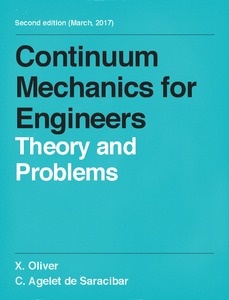Mostra el registre d'ítem simple
Continuum Mechanics for Engineers. Theory and Problems
| dc.contributor.author | Oliver Olivella, Xavier |
| dc.contributor.author | Agelet de Saracibar Bosch, Carlos |
| dc.contributor.other | Universitat Politècnica de Catalunya. Departament d'Enginyeria Civil i Ambiental |
| dc.date.accessioned | 2017-03-28T14:45:12Z |
| dc.date.available | 2017-03-28T14:45:12Z |
| dc.date.issued | 2017-03 |
| dc.identifier.citation | Oliver, X., Agelet de Saracibar, C. "Continuum Mechanics for Engineers. Theory and Problems". 2nd. ed. 2017. |
| dc.identifier.uri | http://hdl.handle.net/2117/102979 |
| dc.description.abstract | This book was born with the vocation of being a tool for the training of engineers in continuum mechanics. In fact, it is the fruit of the experience in teaching this discipline during many years at the Civil Engineering School of the Technical University of Catalonia (UPC/BarcelonaTech), both in undergraduate degrees (Civil Engineering and Geological Engineering) and postgraduate degrees (Master and PhD courses). Unlike other introductory texts to the mechanics of continuous media, the work presented here is specifically aimed at engineering students. We try to maintain a proper balance between the rigor of the mathematical formulation used and the clarity of the physical principles addressed, although always putting the former at the service of the latter. In this sense, the essential vector and tensor operations use simultaneously the indicial notation (more useful for rigorous mathematical proof) and the compact notation (which allows for a better understanding of the physics of the problem). However, as the text progresses, there is a clear trend towards compact notation in an attempt to focus the reader’s attention on the physical component of continuum mechanics. The text content is intentionally divided into two specific parts, which are presented sequentially. The first part (Chapters 1-5) introduces fundamental and descriptive aspects common to all continuous media (motion, deformation, stress and conservation-balance equations). In the second (Chapters 6 to 11), specific families of the continuous medium are studied, such as solids and fluids, in an approach that starts with the corresponding constitutive equation and ends with the classical formulations of solid mechanics (elastic-linear and elasto-plastic) and fluid mechanics (laminar regime). Finally, a brief incursion into the variational principles (principle of virtual work and minimization of potential energy) is attempted, to provide the initial ingredients needed to solve continuum mechanics problems using numerical methods. This structure allows the use of this text for teaching purposes both in a single course of about 100 teaching hours or as two different courses: the first based on the first five chapters dedicated to the introduction of the fundamentals of continuum mechanics and, the second specifically dedicated to solid and fluid mechanics. The theoretical part in every chapter is followed by a number of solved problems and proposed exercises so as to help the reader in the understanding and consolidation of those theoretical aspects. |
| dc.language.iso | eng |
| dc.rights | Attribution-NonCommercial-NoDerivs 3.0 Spain |
| dc.rights.uri | http://creativecommons.org/licenses/by-nc-nd/3.0/es/ |
| dc.subject | Àrees temàtiques de la UPC::Enginyeria mecànica::Mecànica |
| dc.subject | Àrees temàtiques de la UPC::Enginyeria civil::Materials i estructures |
| dc.subject.lcsh | Continuum mechanics |
| dc.title | Continuum Mechanics for Engineers. Theory and Problems |
| dc.type | Book |
| dc.subject.lemac | Mecànica dels medis continus |
| dc.contributor.group | Universitat Politècnica de Catalunya. RMEE - Grup de Resistència de Materials i Estructures en l'Enginyeria |
| dc.identifier.doi | 10.13140/RG.2.2.25821.20961 |
| dc.rights.access | Open Access |
| local.identifier.drac | 19830155 |
| dc.description.version | Postprint (published version) |
| local.citation.author | Oliver, X.; Agelet de Saracibar, C. |
| local.citation.publicationName | Continuum Mechanics for Engineers. Theory and Problems |
| local.citation.edition | 2nd. |


